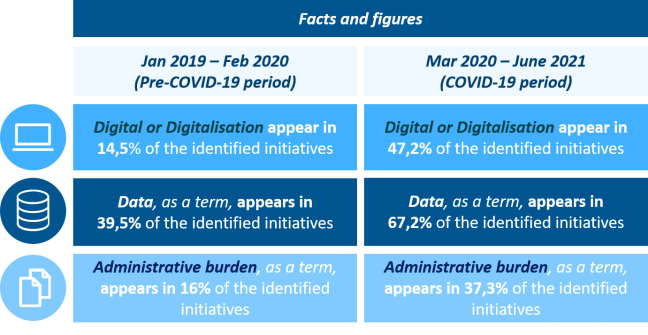The screening of the upcoming policy initiatives of the European Commission on impacts on interoperability and digital implementation is one of our activities in the Legal Interoperability Team.
It helps us understand the current state-of-play, to identify best practices and come up with lessons learned. For this purpose, we assess the keywords that appear either in the description of the published initiatives in the Have your say portal or in their Call for evidence documents.
We had the perception that with COVID-19 the focus of policymakers shifted towards digital issues. Based on our screening of policy initiatives during the last three years, from 2019-2021, before and after the COVID-19 pandemic, we could test if this perception was true.
This report is based on 124 identified initiatives published on the Have Your Say Portal for the period of January 2019 to February 2020 (pre-COVID-19 period) and 284 identified initiatives for the period March 2020 to June 2021 (COVID-19 period).
Numbers show a real boost for the topic

The term digital/digitalisation appeared in almost half of the identified initiatives in the COVID-19 period while in the previous period, only 14,5% of the initiatives were including the term. This is equals a raise of 225%. At the same time, cross-border appeared two times more in the pandemic period than before.

The reference of data raised to 67,2%, increasing the already high percentage of 39,5% in the pre-COVID-19 period, which shows the significant importance of data for policymaking. Also, the term of administrative burden, which is often linked with public services that have a low digital maturity, appeared more than twice as often during the COVID-19 period than before and raised from 16% to 37,3%.

The reference on emerging technologies in policy initiatives was rising during the pandemic. For example, AI (Artificial Intelligence) was mentioned four times more in comparison to the previous period. While, the same applies for the term ‘reuse’ of concepts, frameworks, specification tools and components that act as facilitators of smooth business processes.

During the COVID-19 period from March 2020 to June 2021, 89,4% of the total initiatives identified focused on the European Commission’s priorities (2019-2024). Among them, the second most popular EU Priority was the “Europe fit for the Digital Age” with a 15,1%.
Figure 1: Diagram of the COVID-19 period

If we compare this 15% for files focusing on “A Europe fit for the Digital Age” with the 47% of files mentioning digital and 67% mentioning data during the same period, we see that policymakers address digital issues as a cross-cutting objective spread across various policy fields.
COVID-19 was the accelerator of digitalisation that was already one of the top priorities in the European Commission’s agenda. We assume this comes also as a result of the extensive need for remote communication and collaboration that emerged during the pandemic. It has affected a wide range of policy initiatives issued by multiple DGs. Terms like digital transformation, cross-border, multilateral system, digital communication etc. demonstrated a trend towards the pandemic period.
Our vision
For us, these numbers confirm a growing need for digital-ready policymaking, which enable smooth and digital by default policy implementation through best use of digital technologies and data.
We are continuously working together with different EC services and Member States to produce guidelines and tools for policymakers to deliver on these new objectives, always taking into consideration the evolving IT landscape and policy context.
If you are interested in our work and get in touch or stay up-to-date about the further activities in our BLSI community, subscribe to our newsletter!

